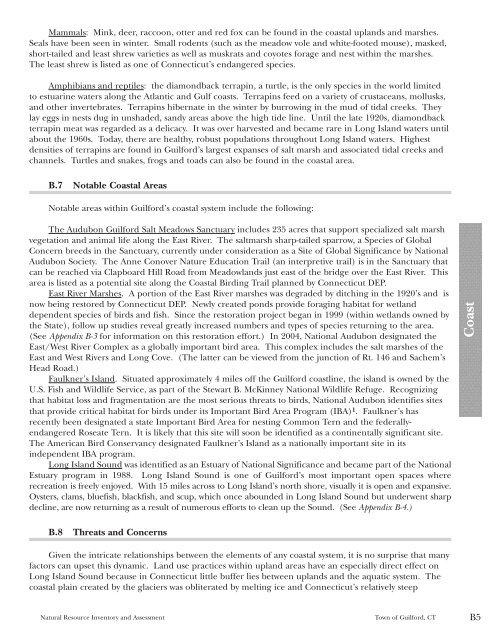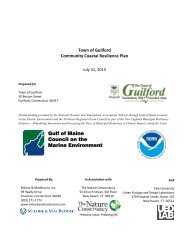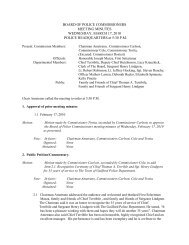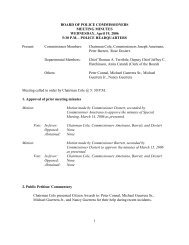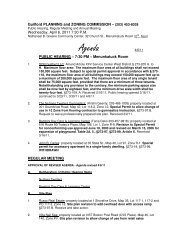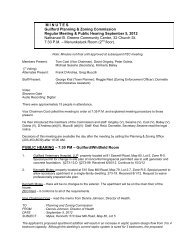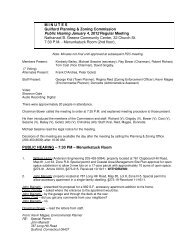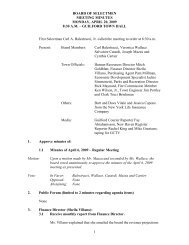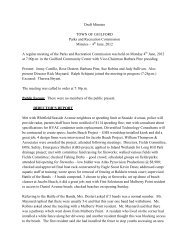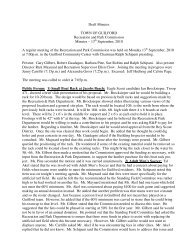Natural Resource Inventory and Assessment - Town of Guilford
Natural Resource Inventory and Assessment - Town of Guilford
Natural Resource Inventory and Assessment - Town of Guilford
You also want an ePaper? Increase the reach of your titles
YUMPU automatically turns print PDFs into web optimized ePapers that Google loves.
Mammals: Mink, deer, raccoon, otter <strong>and</strong> red fox can be found in the coastal upl<strong>and</strong>s <strong>and</strong> marshes.<br />
Seals have been seen in winter. Small rodents (such as the meadow vole <strong>and</strong> white-footed mouse), masked,<br />
short-tailed <strong>and</strong> least shrew varieties as well as muskrats <strong>and</strong> coyotes forage <strong>and</strong> nest within the marshes.<br />
The least shrew is listed as one <strong>of</strong> Connecticut’s endangered species.<br />
Amphibians <strong>and</strong> reptiles: the diamondback terrapin, a turtle, is the only species in the world limited<br />
to estuarine waters along the Atlantic <strong>and</strong> Gulf coasts. Terrapins feed on a variety <strong>of</strong> crustaceans, mollusks,<br />
<strong>and</strong> other invertebrates. Terrapins hibernate in the winter by burrowing in the mud <strong>of</strong> tidal creeks. They<br />
lay eggs in nests dug in unshaded, s<strong>and</strong>y areas above the high tide line. Until the late 1920s, diamondback<br />
terrapin meat was regarded as a delicacy. It was over harvested <strong>and</strong> became rare in Long Isl<strong>and</strong> waters until<br />
about the 1960s. Today, there are healthy, robust populations throughout Long Isl<strong>and</strong> waters. Highest<br />
densities <strong>of</strong> terrapins are found in <strong>Guilford</strong>’s largest expanses <strong>of</strong> salt marsh <strong>and</strong> associated tidal creeks <strong>and</strong><br />
channels. Turtles <strong>and</strong> snakes, frogs <strong>and</strong> toads can also be found in the coastal area.<br />
B.7 Notable Coastal Areas<br />
Notable areas within <strong>Guilford</strong>’s coastal system include the following:<br />
The Audubon <strong>Guilford</strong> Salt Meadows Sanctuary includes 235 acres that support specialized salt marsh<br />
vegetation <strong>and</strong> animal life along the East River. The saltmarsh sharp-tailed sparrow, a Species <strong>of</strong> Global<br />
Concern breeds in the Sanctuary, currently under consideration as a Site <strong>of</strong> Global Significance by National<br />
Audubon Society. The Anne Conover Nature Education Trail (an interpretive trail) is in the Sanctuary that<br />
can be reached via Clapboard Hill Road from Meadowl<strong>and</strong>s just east <strong>of</strong> the bridge over the East River. This<br />
area is listed as a potential site along the Coastal Birding Trail planned by Connecticut DEP.<br />
East River Marshes. A portion <strong>of</strong> the East River marshes was degraded by ditching in the 1920’s <strong>and</strong> is<br />
now being restored by Connecticut DEP. Newly created ponds provide foraging habitat for wetl<strong>and</strong><br />
dependent species <strong>of</strong> birds <strong>and</strong> fish. Since the restoration project began in 1999 (within wetl<strong>and</strong>s owned by<br />
the State), follow up studies reveal greatly increased numbers <strong>and</strong> types <strong>of</strong> species returning to the area.<br />
(See Appendix B-3 for information on this restoration effort.) In 2004, National Audubon designated the<br />
East/West River Complex as a globally important bird area. This complex includes the salt marshes <strong>of</strong> the<br />
East <strong>and</strong> West Rivers <strong>and</strong> Long Cove. (The latter can be viewed from the junction <strong>of</strong> Rt. 146 <strong>and</strong> Sachem’s<br />
Head Road.)<br />
Faulkner’s Isl<strong>and</strong>. Situated approximately 4 miles <strong>of</strong>f the <strong>Guilford</strong> coastline, the isl<strong>and</strong> is owned by the<br />
U.S. Fish <strong>and</strong> Wildlife Service, as part <strong>of</strong> the Stewart B. McKinney National Wildlife Refuge. Recognizing<br />
that habitat loss <strong>and</strong> fragmentation are the most serious threats to birds, National Audubon identifies sites<br />
that provide critical habitat for birds under its Important Bird Area Program (IBA) 1. Faulkner’s has<br />
recently been designated a state Important Bird Area for nesting Common Tern <strong>and</strong> the federallyendangered<br />
Roseate Tern. It is likely that this site will soon be identified as a continentally significant site.<br />
The American Bird Conservancy designated Faulkner’s Isl<strong>and</strong> as a nationally important site in its<br />
independent IBA program.<br />
Long Isl<strong>and</strong> Sound was identified as an Estuary <strong>of</strong> National Significance <strong>and</strong> became part <strong>of</strong> the National<br />
Estuary program in 1988. Long Isl<strong>and</strong> Sound is one <strong>of</strong> <strong>Guilford</strong>’s most important open spaces where<br />
recreation is freely enjoyed. With 15 miles across to Long Isl<strong>and</strong>’s north shore, visually it is open <strong>and</strong> expansive.<br />
Oysters, clams, bluefish, blackfish, <strong>and</strong> scup, which once abounded in Long Isl<strong>and</strong> Sound but underwent sharp<br />
decline, are now returning as a result <strong>of</strong> numerous efforts to clean up the Sound. (See Appendix B-4.)<br />
B.8 Threats <strong>and</strong> Concerns<br />
Given the intricate relationships between the elements <strong>of</strong> any coastal system, it is no surprise that many<br />
factors can upset this dynamic. L<strong>and</strong> use practices within upl<strong>and</strong> areas have an especially direct effect on<br />
Long Isl<strong>and</strong> Sound because in Connecticut little buffer lies between upl<strong>and</strong>s <strong>and</strong> the aquatic system. The<br />
coastal plain created by the glaciers was obliterated by melting ice <strong>and</strong> Connecticut’s relatively steep<br />
<strong>Natural</strong> <strong>Resource</strong> <strong>Inventory</strong> <strong>and</strong> <strong>Assessment</strong> <strong>Town</strong> <strong>of</strong> <strong>Guilford</strong>, CT B5<br />
Coast


